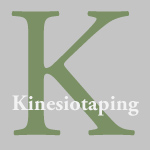 by Rhianna Wagers-Hughes PT, DPT, CEEAA, CSST and future CKTP –Kinesiotaping became popular during the 2008 Beijing Olympics when Kerri Walsh of the U.S. Beach Volleyball Team utilized kinesiotape to her right shoulder during the games. I was interested in learning a new taping method for my geriatric patients in the skilled nursing setting due to what I had read about the benefits of the tape. Kinesiotape is used to facilitate the body’s natural healing process while providing support and stability to muscles and joints without restricting the body’s range of motion as well as providing extended soft tissue manipulation to prolong the benefits of manual therapy administered within the clinical setting. Latex-free and wearable for days at a time, Kinesio® Tex Tape is safe for populations ranging from pediatric to geriatric, and successfully treats a variety of orthopedic, neuromuscular, neurological and other medical conditions.
by Rhianna Wagers-Hughes PT, DPT, CEEAA, CSST and future CKTP –Kinesiotaping became popular during the 2008 Beijing Olympics when Kerri Walsh of the U.S. Beach Volleyball Team utilized kinesiotape to her right shoulder during the games. I was interested in learning a new taping method for my geriatric patients in the skilled nursing setting due to what I had read about the benefits of the tape. Kinesiotape is used to facilitate the body’s natural healing process while providing support and stability to muscles and joints without restricting the body’s range of motion as well as providing extended soft tissue manipulation to prolong the benefits of manual therapy administered within the clinical setting. Latex-free and wearable for days at a time, Kinesio® Tex Tape is safe for populations ranging from pediatric to geriatric, and successfully treats a variety of orthopedic, neuromuscular, neurological and other medical conditions.
I registered for KT1 and 2 in January 2010 and learned the basic methods of kinesiotaping from Amy Stahl PT, CKTI. Immediately, I was able to apply the methods to the geriatric population for lymphatic corrections and facilitation for post-CVA PT in the skilled nursing setting. I contacted the KinesioTaping Association International (KTA) for a specialized geriatric application course so that I could learn specific techniques for the geriatric population. I learned that not many therapists were utilizing the taping techniques with this specific population, so I contacted the APTA and the Geriatric Section so that I could start some case studies with the geriatric population. I have received support from the APTA and KTA in the form of free tape, mounds of information and research articles, and techniques to use with my geriatric patients.
I recently have taken KT3 in McAllen, Texas to learn advanced kinesiotaping techniques for the whole body and to apply the new techniques with the geriatric population at my facility. Outcomes are positive with lymphatic corrections, mechanical corrections and fascial corrections to improve functional mobility and ADL performance with all orthopedic, neurological and neuromuscular patients. I will be taking my certification exam to become a certified kinesiotaping practitioner (CKTP) to add to the many tools in my toolbox to improve the quality of life for my patients.
